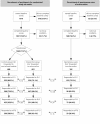Effectiveness of active-online, an individually tailored physical activity intervention, in a real-life setting: randomized controlled trial
- PMID: 19666456
- PMCID: PMC2763402
- DOI: 10.2196/jmir.1179
Effectiveness of active-online, an individually tailored physical activity intervention, in a real-life setting: randomized controlled trial
Abstract
Background: Effective interventions are needed to reduce the chronic disease epidemic. The Internet has the potential to provide large populations with individual advice at relatively low cost.
Objective: The focus of the study was the Web-based tailored physical activity intervention Active-online. The main research questions were (1) How effective is Active-online, compared to a nontailored website, in increasing self-reported and objectively measured physical activity levels in the general population when delivered in a real-life setting? (2) Do respondents recruited for the randomized study differ from spontaneous users of Active-online, and how does effectiveness differ between these groups? (3) What is the impact of frequency and duration of use of Active-online on changes in physical activity behavior?
Methods: Volunteers recruited via different media channels completed a Web-based baseline survey and were randomized to Active-online (intervention group) or a nontailored website (control group). In addition, spontaneous users were recruited directly from the Active-online website. In a subgroup of participants, physical activity was measured objectively using accelerometers. Follow-up assessments took place 6 weeks (FU1), 6 months (FU2), and 13 months (FU3) after baseline.
Results: A total of 1531 respondents completed the baseline questionnaire (intervention group n = 681, control group n = 688, spontaneous users n = 162); 133 individuals had valid accelerometer data at baseline. Mean age of the total sample was 43.7 years, and 1146 (74.9%) were women. Mixed linear models (adjusted for sex, age, BMI category, and stage of change) showed a significant increase in self-reported mean minutes spent in moderate- and vigorous-intensity activity from baseline to FU1 (coefficient = 0.14, P = .001) and to FU3 (coefficient = 0.19, P < .001) in all participants with no significant differences between groups. A significant increase in the proportion of individuals meeting the HEPA recommendations (self-reported) was observed in all participants between baseline and FU3 (OR = 1.47, P = .03), with a higher increase in spontaneous users compared to the randomized groups (interaction between FU3 and spontaneous users, OR = 2.95, P = .02). There were no increases in physical activity over time in any group for objectively measured physical activity. A significant relation was found between time spent on the tailored intervention and changes in self-reported physical activity between baseline and FU3 (coefficient = 1.13, P = .03, intervention group and spontaneous users combined). However, this association was no longer significant when adjusting for stage of change.
Conclusions: In a real-life setting, Active-online was not more effective than a nontailored website in increasing physical activity levels in volunteers from the general population. Further research may investigate ways of integrating Web-based physical activity interventions in a wider context, for example, primary care or workplace health promotion.
Conflict of interest statement
None declared.
Figures





References
-
- Department of Health, authors; Physical Activity, authors; Health Improvement and Prevention, authors. At least five a week: evidence on the impact of physical activity and its relationship to health. London, UK: Department of Health; 2004. 5c6Qz2MVd http://www.dh.gov.uk/en/Publicationsandstatistics/Publications/Publicati....
-
- US Department of Health and Human Services, authors. Physical activity and health: a report of the Surgeon General. Atlanta, GA: US Department of Health and Human Services, Centers for Disease Control and Prevention, National Center for Chronic Disease Prevention and Health Promotion, The President's Council on Physical Fitness and Sports; 1996. 5c6RK3IXQ http://www.cdc.gov/nccdphp/sgr/pdf/sgrfull.pdf.
-
- Bouchard C, Blair SN, Haskell WL. Physical activity and health. Champaign, IL: Human Kinetics; 2007.
-
- Swiss Federal Office of Sport, authors; Swiss Federal Office of Public Health, authors; Health Promotion Switzerland, authors; Network HEPA Switzerland, authors. Health-enhancing physical activity. A base document. Magglingen, Switzerland: Swiss Federal Office of Sport; 2006. 5c6XW7ayL http://www.sport.admin.ch/hepa/downloads/Grundlagendoku_hepa2006_en.pdf.
-
- Stamm H, Lamprecht M. Structural and cultural factors influencing physical activity in Switzerland. J Public Health. 2005;13(4):203–211. doi: 10.1007/s10389-005-0117-y. - DOI

